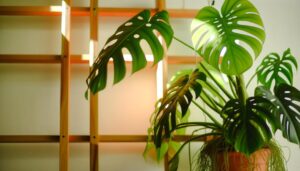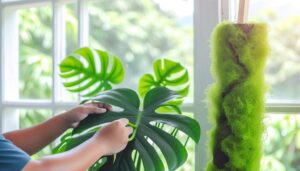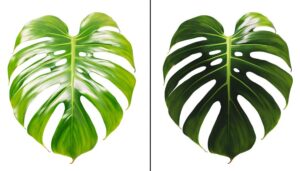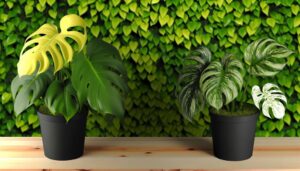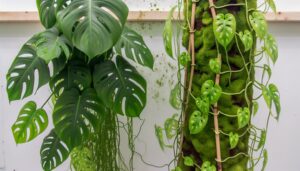Monstera Pinnatipartita Siam
Monstera Pinnatipartita Siam is an intriguing member of the Araceae family, native to the rainforests from Nicaragua to Peru. It displays hemiepiphytic growth and thrives in bright, indirect light with temperatures between 18-27°C.
Its distinctive pinnate leaves have deep lobes and fenestrations. Keep the humidity above 60% and soil well-draining.
Water thoroughly when soil is slightly dry and avoid waterlogging. Watch for pests like aphids and fungal issues such as Fusarium oxysporum.
For propagation, use cuttings with nodes and aerial roots. This species enhances air quality and indoor aesthetics, hinting at intricate care details ahead.
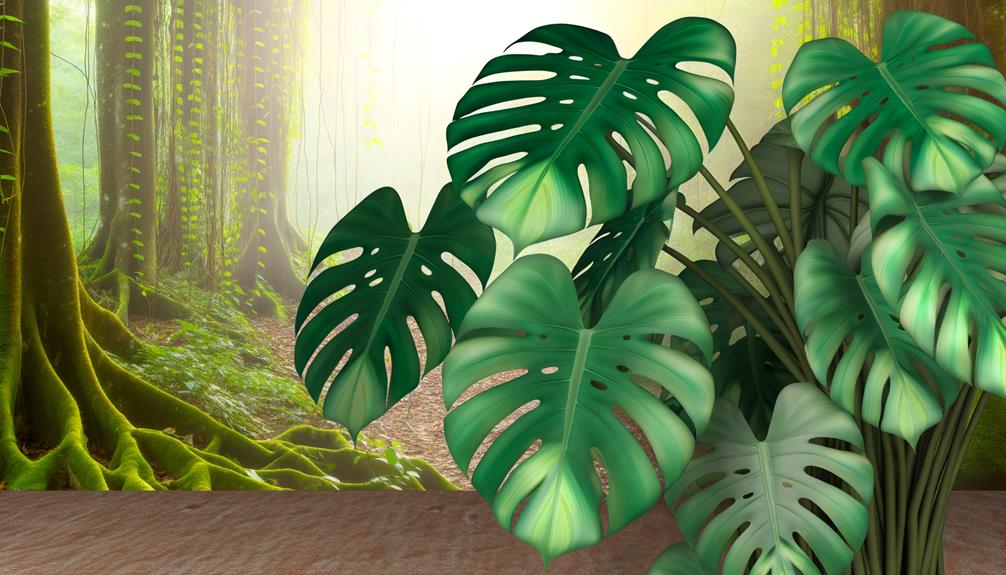
Key Takeaways
- Monstera Pinnatipartita Siam features pinnate leaves with deep lobes and intricate fenestrations.
- Ideal growing conditions include bright, indirect light and temperatures between 18-27°C (65-80°F).
- Maintain humidity above 60% and use well-draining soil to prevent root rot.
- Propagation involves cutting a healthy stem with a node and aerial root, then placing it in a damp substrate.
- The plant improves indoor air quality and regulates humidity through transpiration.
Origin and History

Monstera pinnatipartita, a member of the Araceae family, originates from the tropical rainforests of Central and South America, where it thrives in the humid understory. As an epiphytic species, it relies on the support of larger trees to reach sunlight, exhibiting hemiepiphytic growth patterns.
You'll find that its native habitats range from Nicaragua to Peru, encompassing diverse ecosystems. Historically, indigenous communities utilized Monstera pinnatipartita for its ornamental foliage and occasional medicinal purposes. The plant's adaptability to various altitudes and climates has facilitated its spread.
In recent times, it's gained popularity among horticulturists and indoor plant enthusiasts worldwide, appreciated for its intricate leaf fenestrations and robust growth habit. Understanding its origin helps in replicating its natural conditions for best growth.
Physical Characteristics
You'll frequently notice that the pinnate leaves of Monstera pinnatipartita, scientifically known as Monstera pinnatipartita Schott, exhibit deep lobes and intricate fenestrations, which are key characteristics distinguishing it from other species in the Monstera genus. This tropical plant's foliage showcases a fascinating morphological progression as it matures.
- Juvenile Leaves: These are entire, elliptical, and lack the characteristic fenestrations.
- Intermediate Leaves: As the plant grows, the leaves develop shallow lobes and initial perforations.
- Mature Leaves: Fully mature leaves are pinnately lobed with deep incisions and pronounced fenestrations.
Additionally, the leaf surface is glossy and dark green, reflecting light efficiently, which contributes to its striking appearance.
The aerial roots, essential for climbing and nutrient absorption, are thick and robust, enhancing the plant's structural integrity.
Ideal Growing Conditions
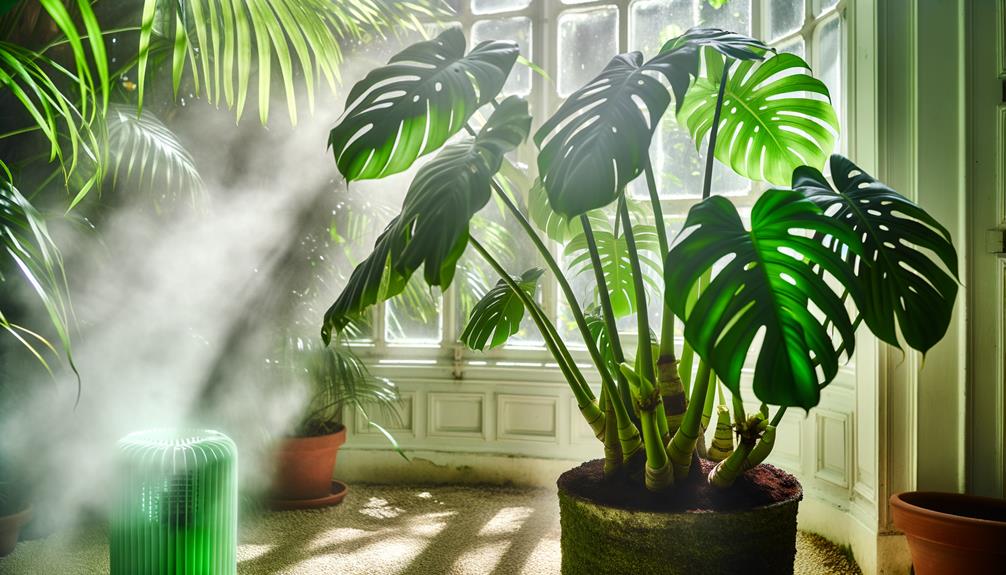
Understanding the best growing conditions for Monstera pinnatipartita Schott is essential to promote its morphological progression and overall health. You should provide it with bright, indirect light to mimic its native tropical understory environment, avoiding direct sunlight to prevent leaf scorch. Maintain temperatures between 18-27°C (65-80°F) and guarantee humidity levels remain above 60%, emulating its natural humid habitat.
| Condition | Optimal Range |
|---|---|
| Light | Bright, indirect light |
| Temperature | 18-27°C (65-80°F) |
| Humidity | Above 60% |
| Soil | Well-draining mix |
Additionally, use a well-draining soil mix abundant in organic matter to support root health and prevent waterlogging. By adhering to these environmental parameters, you'll foster robust growth and vibrant foliage in your Monstera pinnatipartita Schott.
Watering Needs
Consistent and moderate watering is vital for Monstera pinnatipartita Schott, maintaining the soil's moisture while avoiding waterlogging to prevent root rot. You should monitor the moisture levels closely, aiming for a balance that supports healthy growth.
Here's what you need to do:
- Check Soil Moisture: Insert your finger about 2 inches into the soil. If it feels dry, it's time to water.
- Water Thoroughly: Water until you see excess draining from the bottom. This guarantees even hydration.
- Drainage: Always use pots with drainage holes. Stagnant water can lead to root rot (Phytophthora spp.).
Light Requirements
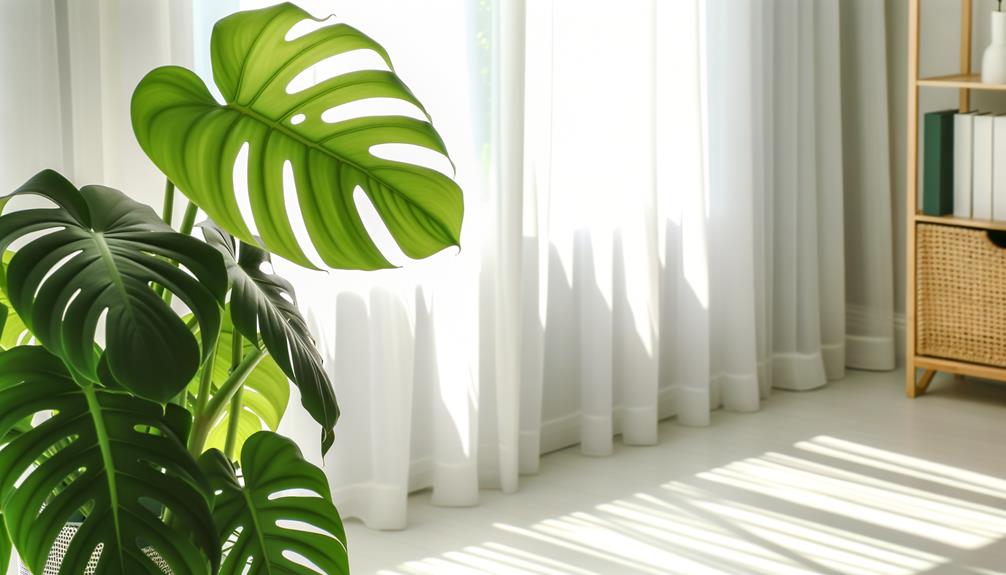
When considering Monstera pinnatipartita Siam, make sure it receives bright, indirect sunlight to mimic its native understory habitat. Positioning the plant indoors near east-facing windows or outdoors in shaded areas prevents photobleaching and leaf burn.
Watch for etiolation and chlorosis as indicators of insufficient light exposure.
Optimal Sunlight Conditions
Monstera pinnatipartita Siam thrives in bright, indirect sunlight, mimicking the dappled light conditions of its native tropical rainforest understory. To achieve this, place it where it receives filtered light but is protected from direct sun, which can scorch its leaves.
Consider the following to optimize light conditions:
- Filtered Light: Use sheer curtains to diffuse sunlight, recreating the natural canopy effect.
- Light Duration: Guarantee 10-12 hours of consistent light daily, as prolonged darkness can stunt growth.
- Light Intensity: Monitor light levels with a lux meter, aiming for 10,000-20,000 lux, which is ideal for Monstera's photosynthetic needs.
Indoor Vs. Outdoor Light
Indoor and outdoor light conditions significantly impact the growth and health of Monstera pinnatipartita Siam, requiring customized approaches based on the environment.
Indoors, you should place your Monstera in bright, indirect light, imitating the dappled sunlight of its native tropical understory. Avoid direct sunlight, which can scorch the leaves. Positioning near an east or north-facing window often works best.
Outdoors, partial shade is optimal. Guarantee it's shielded from harsh midday sun, which can cause cellular damage and affect photosynthesis efficiency. Diffused light under a tree canopy or shaded patio replicates its natural habitat.
Understanding these specific light needs will help you provide the ideal conditions for your Monstera pinnatipartita Siam, promoting vigorous growth and lush foliage.
Signs of Light Stress
Identifying signs of light stress in Monstera pinnatipartita Siam requires close observation of leaf discoloration, wilting, and unusual growth patterns. You'll need to monitor these indicators meticulously.
Leaf Discoloration: Chlorosis or yellowing of the leaves suggests insufficient light. The leaves lose their vibrant green hue due to a reduction in chlorophyll.
Wilting: If the plant appears limp, it might be receiving too much direct sunlight, causing dehydration and cellular damage.
Unusual Growth Patterns: Etiolation, where stems elongate abnormally, indicates the plant is stretching towards a light source, a sign of inadequate light levels.
Soil and Fertilization
To maximize growth for Monstera pinnatipartita Siam, you should use a well-draining soil mix enriched with organic matter and balanced fertilization. A mixture containing equal parts of peat, perlite, and pine bark provides ideal aeration and nutrient retention. Incorporate compost or worm castings to enhance the organic content, supporting root development and overall plant health.
For fertilization, apply a balanced, water-soluble fertilizer with an N-P-K ratio of 20-20-20, diluted to half strength, every 4-6 weeks during the growing season (spring to early autumn). Ensure the soil remains slightly moist but not waterlogged to prevent root rot (Rhizoctonia solani).
Monitoring pH levels, ideally between 5.5 and 6.5, promotes nutrient availability and uptake.
Common Pests and Diseases
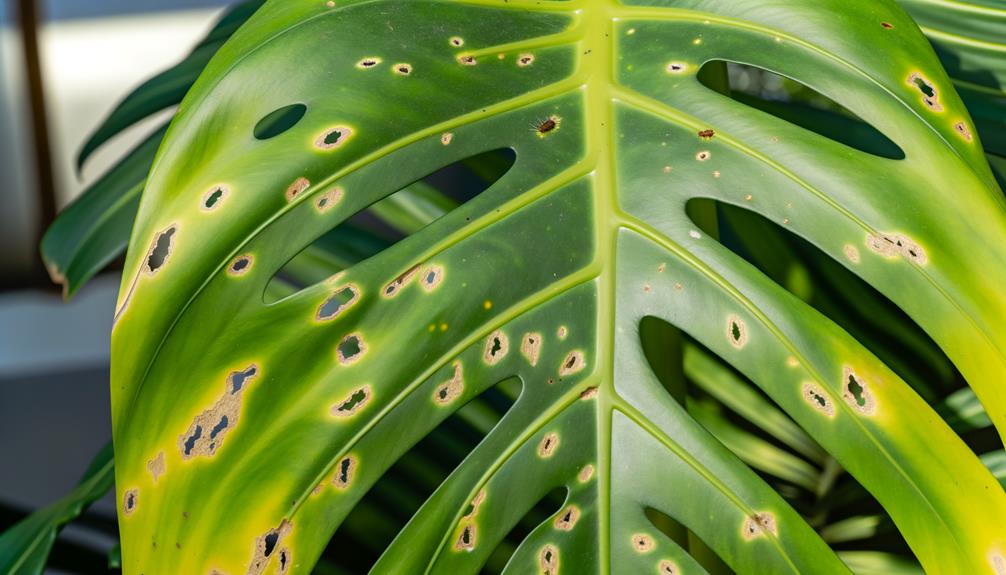
When caring for your Monstera Pinnatipartita Siam, you'll likely encounter common insect infestations such as spider mites (Tetranychus urticae) and scale insects (Coccoidea). These pests can cause chlorosis and stunted growth, making early detection essential.
Additionally, be vigilant for fungal issues like powdery mildew (Erysiphales) and bacterial leaf spot (Xanthomonas campestris), which can be detrimental to your plant's health.
Common Insect Infestations
Over time, Monstera pinnatipartita 'Siam' can become susceptible to common insect infestations such as spider mites (Tetranychidae), mealybugs (Pseudococcidae), and aphids (Aphidoidea), each causing specific damage to its foliage.
You might notice:
- Spider mites (Tetranychidae): Tiny, red or yellowish mites forming web-like structures on leaves, leading to stippling and bronzing.
- Mealybugs (Pseudococcidae): Cotton-like masses on stems and leaf joints, resulting in yellowing, leaf drop, and stunted growth.
- Aphids (Aphidoidea): Small, soft-bodied insects clustering on new growth, causing distorted leaves and excretion of honeydew, which can lead to sooty mold.
Inspect your plant regularly and treat infestations promptly to maintain its health and well-being.
Fungal and Bacterial Issues
Dealing with fungal and bacterial issues in Monstera pinnatipartita 'Siam' often involves identifying and managing pathogens like Fusarium oxysporum, Phytophthora spp., and Xanthomonas campestris, which cause root rot, leaf spot, and bacterial blight, respectively.
You'll notice Fusarium oxysporum manifesting as yellowing leaves and wilting. Phytophthora spp. triggers water-soaked lesions on leaves, eventually leading to brown necrotic areas. Xanthomonas campestris presents as black, irregular spots with yellow halos on foliage.
To manage these, ensure proper drainage, avoid overhead watering, and apply fungicides or bactericides as needed. Regularly inspect your plants, and promptly remove any infected areas to prevent pathogen spread. Maintaining ideal growing conditions can significantly reduce the occurrence of these diseases.
Propagation Techniques
To propagate Monstera Pinnatipartita Siam, start by selecting a healthy, mature stem with at least one node and aerial root. Use sterile pruning shears to make a clean cut below the node.
Follow these steps:
- Rooting Medium: Place the cutting in a damp, well-draining substrate like sphagnum moss or perlite.
- Humidity and Light: Maintain high humidity and indirect light. Use a propagation dome or plastic bag to create a humid environment.
- Root Development: Monitor the cutting for root development, which typically occurs within 4-6 weeks. Ensure the substrate remains moist but not overly saturated.
Benefits of Monstera Pinnatipartita Siam
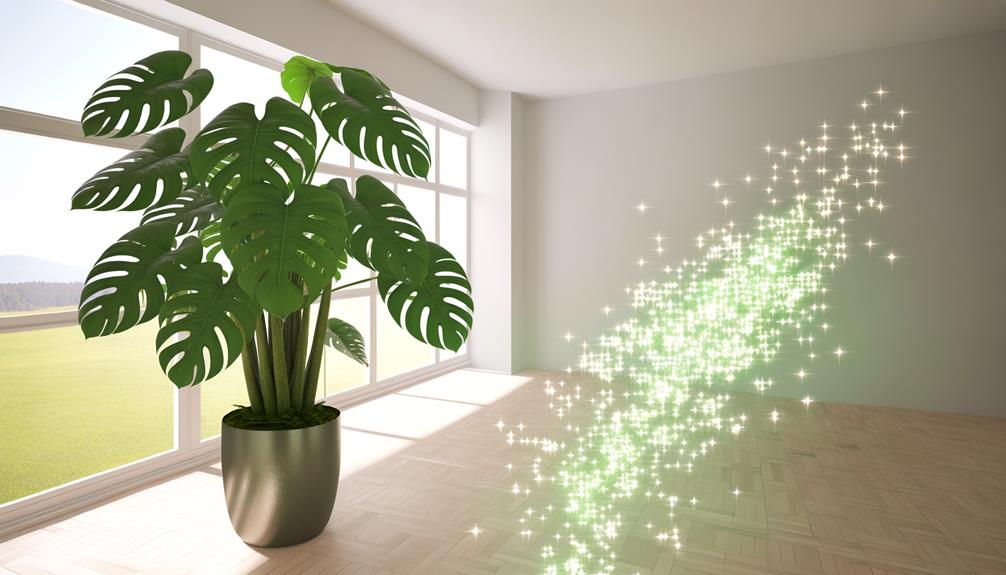
Monstera Pinnatipartita Siam offers numerous benefits, such as improving air quality by filtering airborne toxins like formaldehyde and benzene. Its large, fenestrated leaves increase surface area for maximum photosynthesis, efficiently converting CO₂ into oxygen.
Additionally, Monstera Pinnatipartita Siam contributes to indoor humidity regulation through transpiration. This process releases water vapor, creating a microclimate that can alleviate dry air conditions.
The plant's robust root system also stabilizes indoor soil ecosystems, promoting beneficial microbial activity. Monstera Pinnatipartita Siam's visually appealing foliage can reduce stress and enhance cognitive function, making it an excellent addition to both home and office environments.
Conclusion
To wrap up, if you're craving a plant that requires particular attention like a diva, Monstera pinnatipartita 'Siam' is your ideal choice. Set aside those effortless, easy-care plants; you'll enjoy overseeing its sensitive light and water requirements.
Delight in dealing with *Rhizoctonia solani* and *Aphidoidea* invasions. And propagation? It's essentially a horticultural endurance test! But why settle for simplicity when you can have the plant version of a high-maintenance celebrity in your living space?
Happy growing!

